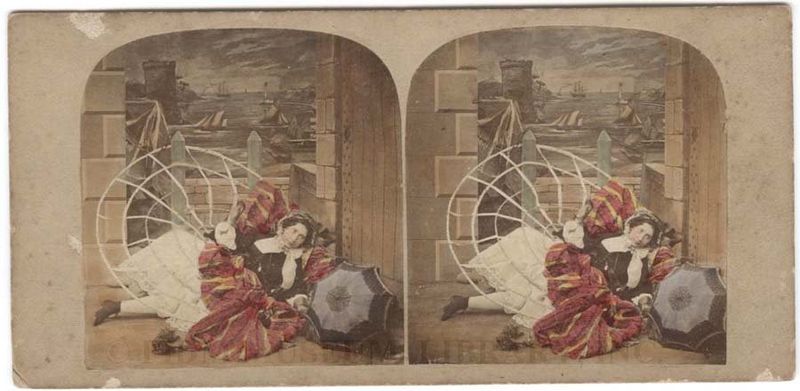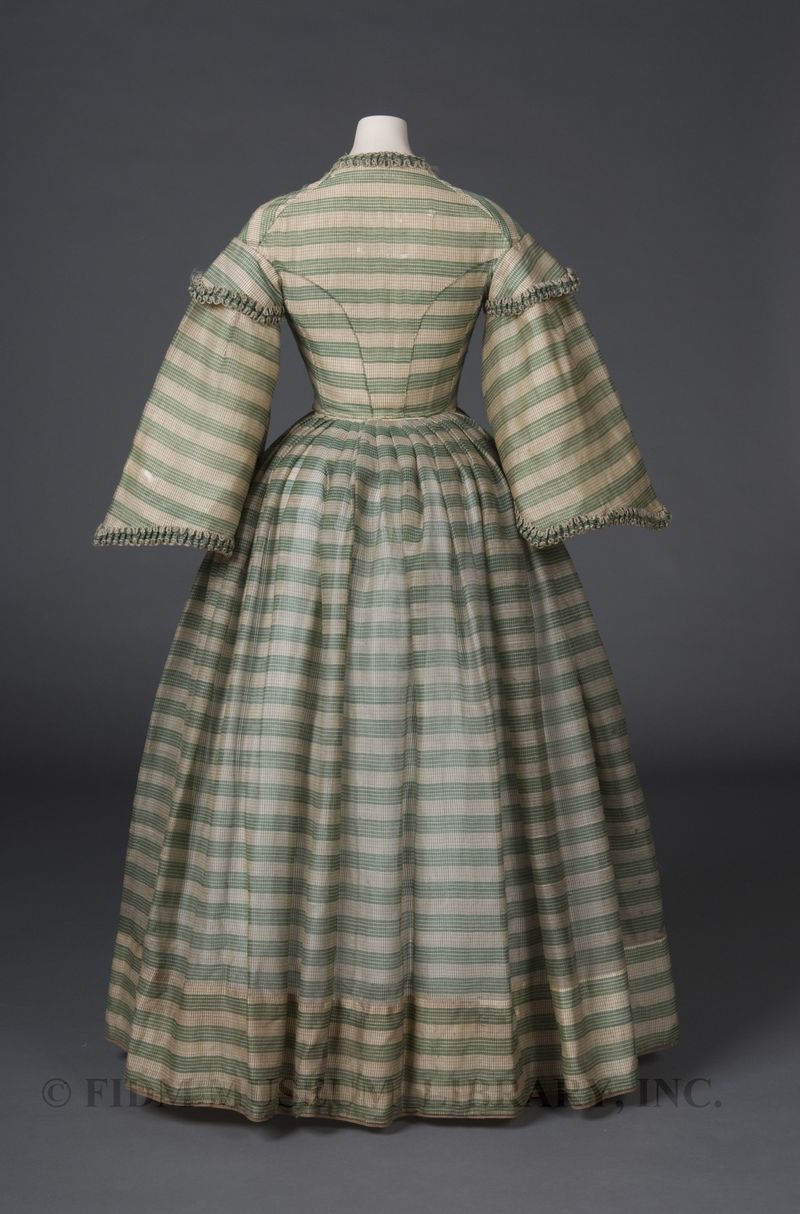In the mid-nineteenth century, the fashionable female silhouette included voluminous, full skirts. To achieve the desired bell-like skirt shape, women relied on multiple layers of petticoats. These petticoats were usually made of linen, cotton or flannel, though some were made of a stiff, woven, horsehair fabric called crinoline. No matter what they were made of, multiple layers of petticoats were cumbersome and heavy. In 1856, the lightweight “cage crinoline” was introduced. Consisting of a series of graduated steel rings or hoops, strung together with thin strips of fabric tape, the cage crinoline provided the same skirt shape with a much reduced weight. Despite its ominous name, it was actually considered a positive innovation because it was lightweight and relatively inexpensive. A cage crinoline would have been worn underneath the striped wool/cotton/silk gauze two-piece dress in the image below.
 Two-piece dress
Two-piece dress
1858-63
Gift of Vicki Nelson
83.530.1AB
The full, bell-like shape of the skirt is echoed by the pagoda sleeves. In the 1850s, sleeves of this type were considered a derivation of Chinese dress. Because they were open at the cuff, undersleeves of lace or delicate cotton lawn would have been worn. The undersleeves would have been tacked to the outer sleeve with a few stitches or would have been fastened above the elbow with a band around the arm. The trim seen on the sleeves and bodice is self-fabric ruching.
Because they were relatively easy to manufacture and
inexpensive, cage crinolines were worn by women of all classes and
ages. A fashion fixture throughout the late 1850s and 1860s, they remained popular until the late 1860s. Humorists, and even some fashion writers, fixated on the cage crinoline as an item of satire because it made sitting, passing through doorways and many other activities unnecessarily difficult. On January 3, 1857, the New York Times noted that “crinolines thrive on caricature.” Windy days were particularly dangerous, as lightweight cage crinolines could sometimes be blown upwards. To protect themselves from this immodesty, many women wore an additional petticoat over or under their cage crinoline. This also softened the line of the steel hoops and provided additional warmth.
In some situations, not even an additional petticoat could protect the wearer’s modesty. In the humorous stereoscope card seen below, a woman has caught the tapes of her crinoline on a fencepost! Titled “Crinoline Difficulties,” it pokes gentle fun at fashionable foibles.
 “Crinoline Difficulties” stereoscope card
“Crinoline Difficulties” stereoscope card
c. 1857
Purchase
2004.5.86
Ashelford, Jane. The Art of Dress: Clothes and Society, 1500-1914. Abrams: New York, 1996.
Severa, Joan. Dressed for the Photographer: Ordinary Americans and Fashion, 1840-1900. Kent State University Press: Ohio, 1995.




I did a research paper at Ryerson University on the cage crinoline this summer and learned that the crinoline was the first garment worn by all classes of women. The relatively inexpensive price made it accessible to all and in spite of the inherent dangers of wearing a large skirt that could potentially be caught in a machine or catch on fire from an open flame, it was incredibly popular even among working class women.
I also find the shape of the crinoline inherently beautiful as a sculptural object and this inspired my recent art work.
My research resulted in the same findings that you mention in your comment, Ingrid. According to the Jane Ashelford book I listed as one of the sources, even after crinolines went out of fashion (about 1868) servants were often expected to wear crinolines as part of their uniform. Sounds like it would make household tasks very difficult to complete!
“The Art of Dress” referenced by “Rachel” is by JANE Ashelford (not Joan Ashelford).
rdunlap@tsf.net
Thank you for the correction, Ruth. You’ll notice I’ve changed the citation in the entry.
Note also in the side view, that quite a substantial baby bump could be hidden underneath one, a boon to those who would otherwise have had to retire from society much earlier to avoid the embarrassment of being seen to be pregnant!
Great point! I hadn’t thought of this, but you’re absolutely correct that the bell shape of the crinoline would easily hide a baby bump. It makes an interesting comparison to today’s maternity fashions, wherein baring the bump is the primary goal.